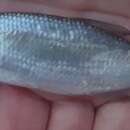Diagnostic Description
(
англиски
)
добавил Fishbase
Differs from other species of shemayas by the combination of the following characters: origin of anal fin about 1½ -2½ scales behind dorsal-fin base; anal fin with 15-17½ branched rays; gill rakers 27-34; length of gill raker at angle between upper and lower limbs of first gill arch 30-55% of opposite inner gill filament; lateral line scales 56-63 + 4-5; ventral keel exposed for 4-6 scales in front of anus, reaching about 25% of distance between anus and pelvic-fin base; head length 21-23% SL; predorsal length 53-58% SL; caudal peduncle depth 6.9-8.1% SL,1.7-2.0 times in its length; eye diameter 4.8-5.8% SL, 1.3-1.6 times in interorbital distance; presence of numerous small tubercles in nuptial males; absence of faint, dark midlateral stripe (Ref. 75106).Description: dorsal fin with 8½ branched rays; anal fin with 15 -17½ branched rays (Ref. 75106).
- лиценца
- cc-by-nc
- авторски права
- FishBase
Life Cycle
(
англиски
)
добавил Fishbase
Deposits sticky eggs which adhere on pebbles or stones (Ref. 59043).
- лиценца
- cc-by-nc
- авторски права
- FishBase
Biology
(
англиски
)
добавил Fishbase
Inhabits lower and middle parts of large rivers, estuaries, coastal lakes and adjacent areas of seas where salinity is lowered by large inflow of freshwater. Can tolerate salinities of up to 12 ppt. Adults mainly prey on planktonic crustaceans, terrestrial insects, and small fish. Larvae and young juveniles feed on zooplankton, algae and insect larvae. Spawns in riffles with heavy current on gravel bottom. There are semi-anadromous and riverine populations. Anadromous populations commence to enter rivers in autumn and move upstream in winter and/or spring. Adults move back to the sea soon after spawning to forage. Young individuals migrate downriver in autumn of same year or the following spring. Hybridizes with Squalius cephalus. All populations sharply declined in the early and middle 20th century due to the constructed dams that hindered in reaching the spawning grounds. Today, spawning occurs only below these dams (Ref. 59043).
- лиценца
- cc-by-nc
- авторски права
- FishBase
Alburnus sarmaticus: Brief Summary
(
англиски
)
добавил wikipedia EN
Alburnus sarmaticus is a species of ray-finned fish in the genus Alburnus. Widespread in European rivers: Southern Bug, Dnieper, Danube (in Romania, Ukraine and Bulgaria); River Kolpa, an upper tributary to the River Sava in Croatia and Slovenia. Almost extirpated in Danube, to be probably survived only in River Kolpa.
- лиценца
- cc-by-sa-3.0
- авторски права
- Wikipedia authors and editors

